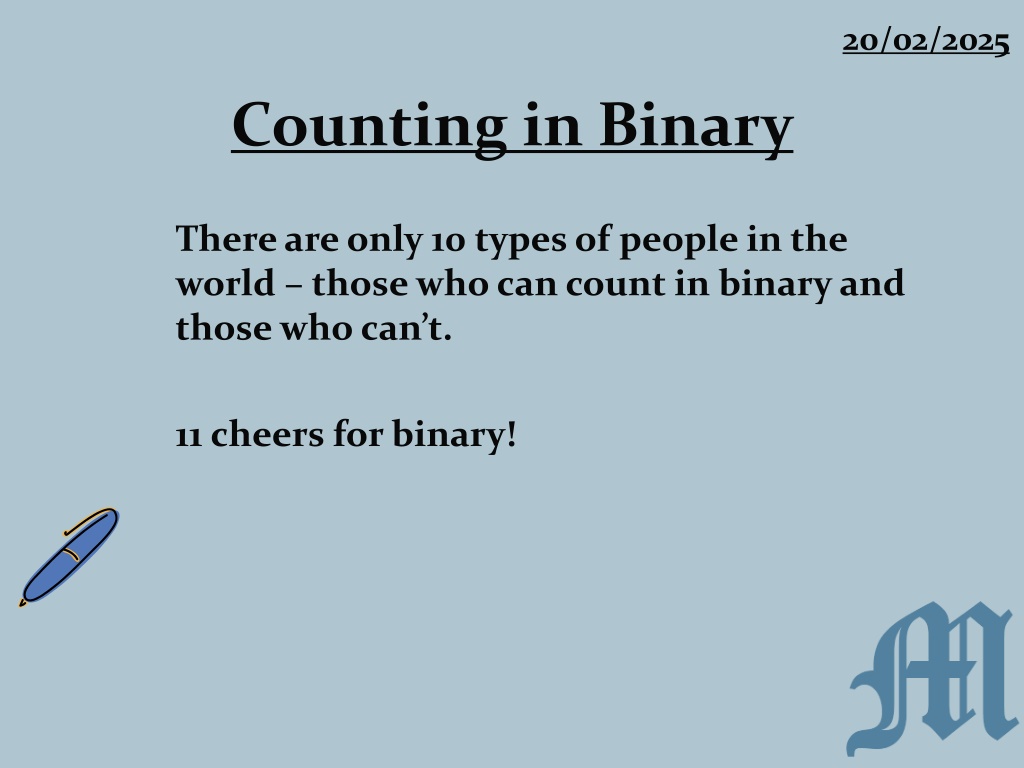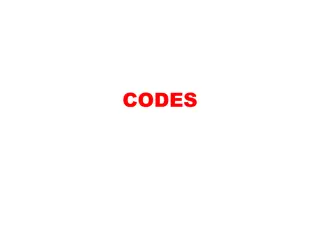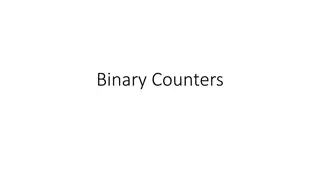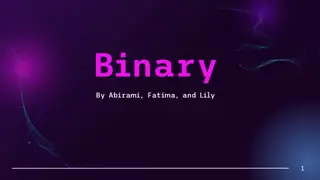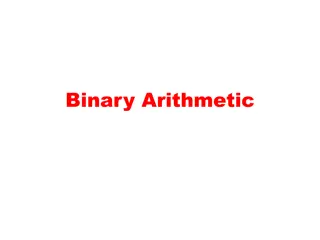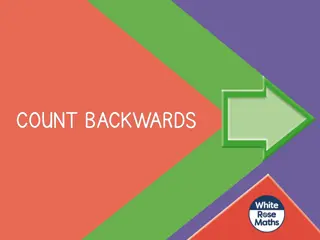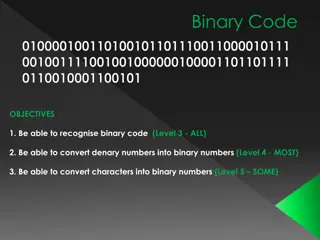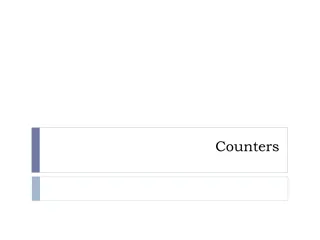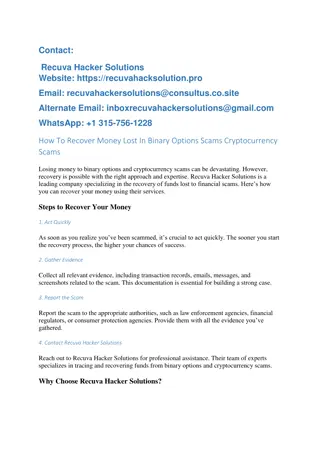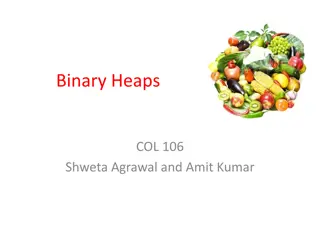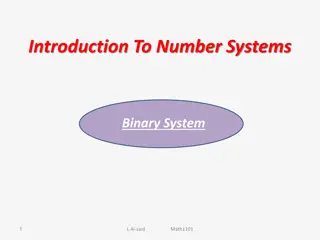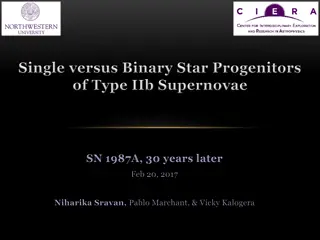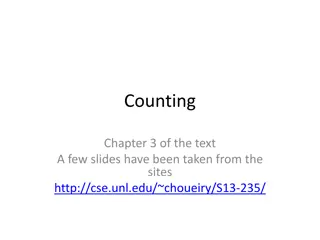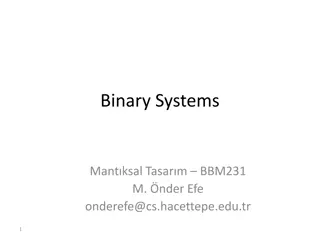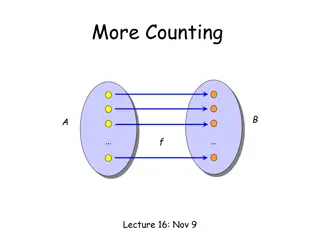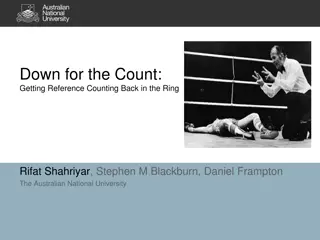Counting in Binary
Delve into the fundamentals of binary counting, denary representation, and conversion methods between the two number systems. Explore the significance of digits, understand how numbers are broken down, and learn the step-by-step processes for converting binary to denary and vice versa. Master the art of counting in binary and grasp the principles behind the base-2 numeral system efficiently.
Download Presentation

Please find below an Image/Link to download the presentation.
The content on the website is provided AS IS for your information and personal use only. It may not be sold, licensed, or shared on other websites without obtaining consent from the author.If you encounter any issues during the download, it is possible that the publisher has removed the file from their server.
You are allowed to download the files provided on this website for personal or commercial use, subject to the condition that they are used lawfully. All files are the property of their respective owners.
The content on the website is provided AS IS for your information and personal use only. It may not be sold, licensed, or shared on other websites without obtaining consent from the author.
E N D
Presentation Transcript
20/02/2025 Counting in Binary There are only 10 types of people in the world those who can count in binary and those who can t. 11 cheers for binary!
Lesson Objective: Can you remember how to count in binary? Success Criteria: L1 I can calculate the integers 1-10 in binary L2 I can convert a binary number into denary L3 I can also convert a denary number into binary
Denary (known as Base 10) 3-4 How many digits are used in denary counting? What are they? Why this many? 5-6 Explain how the number 152 is broken down in denary counting (and why). 7-9 Explain how denary counting works (including an example).
Answers 3-4 10 digits are used (0-9). This is because humans have 10 fingers! 5-6 The number 152 is broken down into 1x hundred, 5 x ten and 2 x single units: 100s 10s 1s 1 5 2 7-9 We start with 0 in the units column. When we reach 9 we then add a 1 into the next column (the 10s) and start again with 0 in the units. We keep repeating this until we reach 9 in the tens column. When this happens we add a 1 in the next column (the hundreds) and repeat the process.
Binary (Base 2) 3-4 How many numerals are used in binary counting (and why?) 5-6 Explain how the number 4 is represented in binary (and why). 7-9 Explain how binary counting works (including an example).
Binary (Base 2) 3-4 2 1s and 0s. This is because the millions of transistors in a computer can only be on (1) or off (0). 5-6 The number 4 is represented by 1 x four, 0 x two and 0 x 1. 4s 2s 1s 1 0 0 7-9 We start with 0 in the units column. When we reach 1 we then add a 1 into the next column (the twos) and start again with 0 in the units. We keep repeating this until we reach 1 in the twos column. When this happens we add a 1 in the next column (the fours) and repeat the process.
Converting Binary to denary Write down all the columns that have a 1 in it 1. 2. Add all of these numbers up Eg: 128 64 32 16 8 4 1 0 1 2 0 1 1 1 1 0 1 = 5 = 2 0 1 1 1 1 = 127
Converting Denary to Binary Start from the left 1. 2. If this digit can fit into your integer then add a 1 to this column. Subtract the digit from your number 3. Keep repeating this until you get to 0 Eg: 128 64 32 16 8 4 1 0 1 2 0 1 1 1 1 0 1 10 = 73 = 0 1 1 1 1 145 =
Mini-test 1) Write down the integers 1-10 in binary 2) Convert the following numbers into denary: 1011 1001 1111 3) Convert the following numbers into binary: 31 13 18
Answers 1) 1, 10, 11, 100, 101, 110, 111, 1000, 1001, 1010 2) Convert the following numbers into denary: 1011 11 1001 9 1111 15 3) Convert the following numbers into binary: 31 11111 13 1101 18 10010
Lesson Objective: Can you remember how to count in binary? Success Criteria: L1 I can calculate the integers 1-10 in binary L2 I can convert a binary number into denary L3 I can also convert a denary number into binary
Representing characters as binary Add today s title to your book. 1) On a whiteboard, convert the following denary numbers to binary 16 9 2) 27 On a whiteboard, convert the following binary numbers to denary: 1001 000111 10101010 3)
Lesson Objective: How can a computer store characters as binary data? Success Criteria: L1 I can explain what a character set is. L2 I can explain how character sets are used to represent characters as binary. L3 I can explain the difference between ASCII and Unicode and where each might be used.
ASCII Using these decimal codes, what would the word Computing look like?
ASCII This code is called ASCII (American Standard Code for Information Interchange) and is used to allow the computer to understand the characters that have been typed in by a human. The word Computing uses the denary codes: 67 111 109 112 117 116 105 110 103 Obviously the computer would recognise these in Binary as: 01000011 01101111 01101101 01110000 01110101 01110100 01101001 01101110 01100111 Each character is given a unique binary code and that is how the computer can represent the correct character. L1 What does ASCII stand for? L2 How is the word Computing translated to binary? L3 What is the maximum number of characters that could be translated using 1 byte?
ASCII This code is called ASCII (American Standard Code for Information Interchange) and is used to allow the computer to understand the characters that have been typed in by a human. The word Computing uses the denary codes: 67 111 109 112 117 116 105 110 103 Obviously the computer would recognise these in Binary as: 01000011 01101111 01101101 01110000 01110101 01110100 01101001 01101110 01100111 Each character is given a unique binary code and that is how the computer can represent the correct character. L1 American Standard Code for Information Interchange. L2 Each character has a unique denary code. This is then translated into 8 bit binary codes. This creates one long binary string. L3 255 characters can be represented using one byte.
Number of bits ASCII uses 1 byte to store all of the characters needed for the English language. This gives 256 possible characters which is enough for the English language. However what would other languages use such as Arabic where they have thousands of characters?
Character Set ASCII and Unicode are the most widely used character sets. The term Character set is used to describe the possible characters that can be represented in a computer system. L1 Define the term Character set . L2 What do you think the Uni part of Unicode could mean? L3 Which character set do you think uses the most memory per character? Why?
Character Set ASCII and Unicode are the most widely used character sets. The term Character set is used to describe the possible characters that can be represented in a computer system. L1 It is a code that can be used to represent characters. L2 The Uni part of Unicode represents the word Universal . This is because it can be used to represent any language in the world. L3 Unicode uses the most memory per character this is because there are more than 255 different characters in all the languages in the world.
Unicode Unicode was developed to account for every language in the world. It uses 2 bytes that give us 216 possibilities (65,536). An example use of this would allow a user from any country to select their language when setting up an operating system. The Unicode character set would account for every language. L1 What languages can be represented by Unicode? L2 How many bytes does each Unicode character use? How many characters can be represented in Unicode? L3 What character set do you think would be used on a computer today. Why?
Unicode Unicode was developed to account for every language in the world. It uses 2 bytes that give us 216 possibilities (65,536). An example use of this would allow a user from any country to select their language when setting up an operating system. The Unicode character set would account for every language. L1 Any language in the world can be represented by Unicode. L2 Unicode uses 2 bytes per character. This means 65,536 characters can be represented by Unicode. L3 Computers tend to have both character sets this means it can communicate with any computer, no matter which character set it might be using.
Mini-test Write out the following strings in ASCII code (denary): Hello, Mayfield 1) 2) Write out the following strings in 8 bit binary: Bat, Ball 3) Choose any verb of your choice write this out in 8 bit binary
Answers 1) Hello = 72 101 108 108 111 Mayfield = 77 97 121 102 105 101 108 100 2) Bat = 01000010 01100001 01110100 Ball = 01000010 01100000 01101100 01101100
Lesson Objective: How can a computer store characters as binary data? Success Criteria: L1 I can explain what a character set is. L2 I can explain how character sets are used to represent characters as binary. L3 I can explain the difference between ASCII and Unicode and where each might be used.
